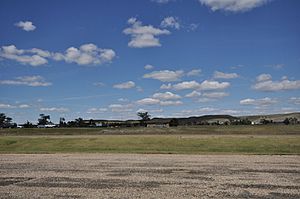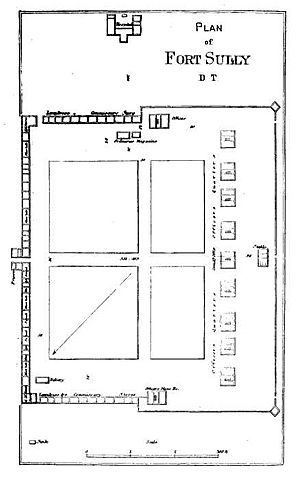Fort Sully (South Dakota) facts for kids
Quick facts for kids Fort Sully |
|
|---|---|
| old Fort Sully: Hughes County, about 4.5 miles southeast of Pierre, South Dakota Fort Sully II: Sully County, 30 miles farther up, and on the same side of the Missouri, and about 20 miles below the mouth of the Cheyenne River. | |
| Site information | |
| Controlled by | United States |
| Site history | |
| Built | 1863 and 1866 |
| In use | 1863-1894 |
| Battles/wars | Indian Wars |
| Garrison information | |
| Past commanders |
|
| Garrison | 30th Wisconsin 6th Iowa Cavalry 4th U.S.V.I. 22nd U.S. Infantry 1st U.S. Infantry 11th U.S. Infantry 12th U.S. Infantry |
Fort Sully was an important military fort. It was built on the east side of the Missouri River in what is now South Dakota. This fort was used during the American Indian Wars.
There were actually two forts called Sully. The first, Old Fort Sully, was used from 1863 to 1866. The second, New Fort Sully, was built in 1866. It stayed active until 1894.
Old Fort Sully: The First Fort
Old Fort Sully 44°20′46″N 100°16′29″W / 44.34611°N 100.27472°W was located in Hughes County, South Dakota. It was built in September 1863. The fort was named after Major General Alfred Sully.
It stood about 80 rods (around 1,320 feet) from the east bank of the Missouri River. This spot was near Farm Island, southeast of today's city of Pierre, South Dakota. The fort was 270 feet (82 meters) square. It was made from cottonwood trees found on Farm Island.
Why Was Old Fort Sully Built?
General Sully's soldiers used Old Fort Sully. They were part of campaigns against the Sioux people from 1863 to 1865. The fort was abandoned in the fall of 1866. This was because its location on the lowlands near the Missouri River was unhealthy.
Today, you can find the site of Old Fort Sully. It is located within the Farm Island State Recreation Area.
Who Served at Old Fort Sully?
The fort was ready for troops by October 13, 1863. Lieutenant Colonel E. M. Bartlett of the Thirtieth Wisconsin Regiment took command. He announced that the post would be called Fort Sully. This was to honor General Alfred Sully.
Different military units served here. These included:
- The Thirtieth Wisconsin Volunteer Infantry.
- The Sixth Iowa Cavalry.
- The Seventh Iowa Cavalry.
For example, Company K of the 6th Iowa Cavalry spent the winter of 1863-1864 at the fort. They later joined General Sully's trip to the Devil's Lake area.
Treaty of Fort Sully: A Peace Agreement
A special agreement was made at Fort Sully. It was a treaty between the United States and the Yanktonai band of Dakota or Sioux Indians. This treaty was signed on October 20, 1865.
In this treaty, the Yanktonai band agreed to be under the authority of the United States. They promised to stop fighting against American citizens. They also agreed to help prevent other Native American groups from attacking the United States.
In 1866, Old Fort Sully was briefly under the Department of the Platte. It then became part of the Department of Dakota. This department was part of the new Division of Missouri.
Fort Sully II: The New Fort
The new Fort Sully was started in July 1866. It was finished in 1868. This new fort 44°35′17″N 100°35′24″W / 44.58806°N 100.59000°W was in Sully County, South Dakota. Its location was much better and healthier than the old fort.
It was a perfect spot for defense. The fort stood on a high, flat area. This plateau was about 160 feet (49 meters) above a wide valley of the Missouri River. It was also about the same height above the surrounding prairie. New Fort Sully was a very important military fort in Dakota for many years.
Where Was the New Fort Located?
Fort Sully II was on the east bank of the Missouri River. It was about 20 miles (32 km) below the mouth of the Cheyenne River. The fort was about 2,000 feet (610 meters) above sea level.
It was roughly halfway between the start of river navigation at Fort Benton, Montana and the mouth of the Missouri. The nearest town was Yankton, about 300 miles (483 km) downriver. Other nearby forts included Fort Randall and Fort Rice.
The fort was built on a "third terrace," a flat area 160 feet (49 meters) above the river's low-water mark. To the south, the land sloped into a deep, dry ditch. To the west, the land dropped sharply to a lower terrace. This lower area held stables, a granary, a sawmill, and other buildings. Below that was the river bottom. This area was sometimes flooded but had good timber and fertile soil. Here, the soldiers grew gardens.
What Did the New Fort Look Like?
Fort Sully II was designed for four companies of soldiers. The soldiers' living quarters were in two long buildings. Each building was 350 feet (107 meters) long and 17 feet (5.2 meters) wide. They were placed end-to-end with a 15-foot (4.6 meter) gap, which formed the main entrance.
These buildings were made of cottonwood logs. They had pine siding, plaster, and 12-foot (3.7 meter) high ceilings. Inside, partitions divided the buildings into sleeping areas, dining rooms, and kitchens. Each sleeping room was 20 by 17 feet (6.1 by 5.2 meters). It was meant for 16 men. The beds were rough wooden double bunks. There were no indoor washrooms or bathrooms.
The officers had nine separate buildings. These were made of pine and had brick foundations. Each officer's house had a kitchen in the back. All rooms were plastered. Some houses had four rooms, a hall, and a pantry. None of the officers' quarters had bathrooms.
The guard and prison rooms were at the ends of the main barracks building. The prisoners' room was 15 by 15 feet (4.6 by 4.6 meters). There were also large storehouses for supplies. The hospital was located near a ravine to the south of the fort.
Who Served at the New Fort?
Different infantry regiments served at Fort Sully II for many years.
22nd Infantry
The 22nd Infantry served at the fort for seven years, from 1866 to 1873.
1st Infantry
The 1st Infantry was stationed there for four years, from 1874 to 1879.
11th Infantry
The 11th Infantry served for nine years, from 1879 to 1887. In December 1878, Company A of the 11th U.S. Infantry moved to Fort Sully. By October 1879, Companies A and K were there. In December 1879, the headquarters, band, and Companies G and I also moved to Fort Sully.
On February 12, 1884, a fire broke out at Fort Sully. It started by accident in Company A's quarters. The fire destroyed several buildings. This included the quarters for Company A and the band. It also burned the guardhouse and parts of Company E and K's quarters. Company A had to move temporarily to Fort Bennett.
12th Infantry
The 12th Infantry served at the fort for 12 years, from 1887 to 1894.
On October 20, 1894, Major Gageby and Companies B, C, and D of the 12th Infantry left Fort Sully. They were headed to Fort Niobrara in Nebraska. With their departure, Fort Sully was abandoned.



